
MaixPy
Easily create AI projects with Python on edge device
Stars: 219
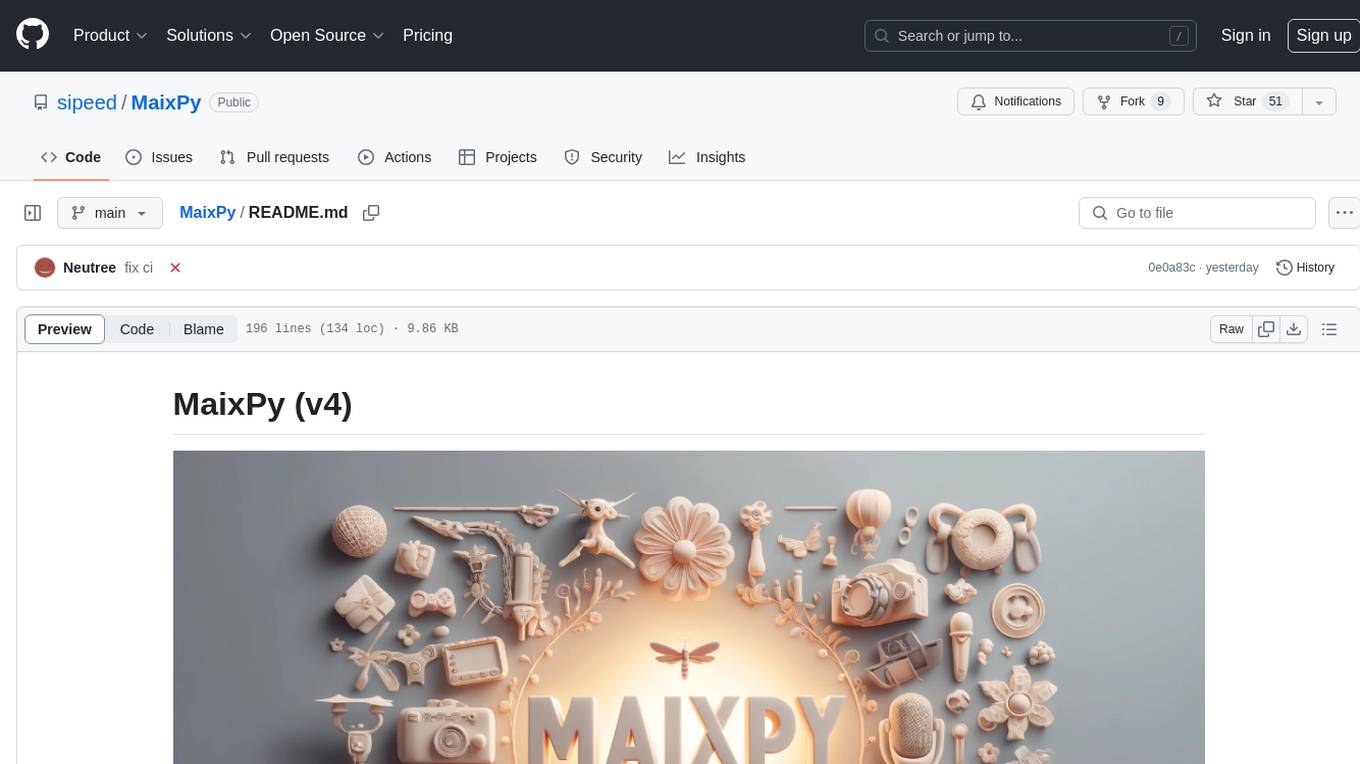
MaixPy is a Python SDK that enables users to easily create AI vision projects on edge devices. It provides a user-friendly API for accessing NPU, making it suitable for AI Algorithm Engineers, STEM teachers, Makers, Engineers, Students, Enterprises, and Contestants. The tool supports Python programming, MaixVision Workstation, AI vision, video streaming, voice recognition, and peripheral usage. It also offers an online AI training platform called MaixHub. MaixPy is designed for new hardware platforms like MaixCAM, offering improved performance and features compared to older versions. The ecosystem includes hardware, software, tools, documentation, and a cloud platform.
README:
Let's Sipeed up, Maximize AI's power!
MaixPy (v4): Easily create AI projects with Python on edge device
Quick Start | Documentation | API | Hardware
English | 中文
New MaixPy (v4) and new hardware platform MaixCAM is coming now!
If you have any suggestions, tell us on MaixHub, or Telegram/MaixPy or QQ group: 862340358.Click the Star in the upper right corner to let us know you like it to encourage us to add more features.
With MaixPy you can easily create AI vision project within 10 lines of code:
from maix import camera, display, image, nn
classifier = nn.Classifier(model="/root/models/mobilenetv2.mud")
cam = camera.Camera(classifier.input_width(), classifier.input_height(), classifier.input_format())
disp = display.Display()
while 1:
img = cam.read()
res = classifier.classify(img)
max_idx, max_prob = res[0]
msg = f"{max_prob:5.2f}: {classifier.labels[max_idx]}"
img.draw_string(10, 10, msg, image.COLOR_RED)
disp.show(img)Result video:
Classifier Result videoSimply use peripheral like serial port:
from maix import uart
devices = uart.list_devices()
serial = uart.UART(devices[0], 115200)
serial.write_str("hello world")
print("received:", serial.read(timeout = 2000))We also provide a handy MaixVision workstation software to make development easier and faster:
MaixVisionAnd online AI train platform MaixHub, one click to train AI model and deploy to MaixCAM even you have no AI knowledge and expensive training equipment.
Python programing, MaixVision Workstation, AI vision, video streaming, voice recognize, peripheral usage etc.
Details and videos visit official site: wiki.sipeed.com/maixpy/
And we provide new powerful hardware platform MaixCAM and MaixCAM-Pro:
| CPU | NPU | Memory |
|---|---|---|
| - 1GHz RISC-V(Linux)/ARM A53 - 700MHz RISCV-V(RTOS) - 25~300MHz 8051(LowPower) |
1Tops@INT8 NPU, support BF16 support YOLOv5 YOLOv8 etc. |
256MB DDR3 |
| Connecting | Peripheral | MultiMedia | Buy |
|---|---|---|---|
| USB2.0/WiFi6/BLE5.4 | IIC/PWM/SPI/UART/WDT/ADC | - 4M Camera - 2.3" 552x368 Touchscreen - H.264/H.265/MJPEG codec |
Sipeed Official Store |
Chip register level open, more detalils: MaixCAM-Pro or MaixCAM
- Maix-I K210 series is outdated, MaixPy v4 not support it, use it please visit MaixPy-v1
- AI Algorithm Engineer who want to deploy your AI model to embedded devices.
MaixPy provide easy-to-use API to access NPU, and docs to help you develop your AI model.
- STEM teacher who wants to teach AI and embedded devices to students.
MaixPy provide easy-to-use API, PC tools, online AI train service ... Let you focus on teaching AI, not the hardware and complicated software usage.
- Maker who want to make some cool projects but don't want to learn complicated hardware and software.
MaixPy provide Python API, so all you need is learn basic Python syntax, and MaixPy's API is so easy to use, you can make your project even in a few minutes.
- Engineer who want to make some projects but want a prototype as soon as possible.
MaixPy is easy to build projects, and provide corresponding C++ SDK, so you can directly use MaixPy to deploy or transfer Python code to C++ in a few minutes.
- Students who want to learn AI, embedded development.
We provide many docs and tutorials, and lot of open source code, to help you find learning route, and grow up step by step. From simple Python programming to
Vision,AI,Audio,Linux,RTOSetc.
- Enterprise who want to develop AI vision products but have no time or engineers to develop complicated embedded system.
Use MaixPy even graphic programming to develop your products with no more employees and time. For example, add a AI QA system to your production line, or add a AI security monitor to your office as your demand.
- Contestants who want to win the competition.
MaixPy integrate many functions and easy to use, fasten your work to win the competition in limited time. There are already many contestants win the competition with MaixPy.
K210 and v831 are outdated, they have many limitations in memory, performance, NPU operators missing etc.
No matter you are using them or new comer, it's recommended to upgrade to MaixCAM and MaixPy v4.
Here's the comparison between them:
| Feature | Maix-I K210 | Maix-II v831 | MaixCAM |
|---|---|---|---|
| CPU | 400MHz RISC-V x2 | 800MHz ARM7 | 1GHz RISC-V(Linux) 700MHz RISC-V(RTOS) 25~300MHz 8051(Low Power) |
| Memory | 6MB SRAM | 64MB DDR2 | 256MB DDR3 |
| NPU | 0.25Tops@INT8 official says 1T but... |
0.25Tops@INT8 | 1Tops@INT8 |
| Encoder | ✖ | 1080p@30fps | 2K@30fps |
| Screen | 2.4" 320x240 | 1.3" 240x240 | 2.28" 552x368 / 5" 1280x720 / 7" 1280x800 / 10“ 1280x800 |
| TouchScreen | ✖ | ✖ | 2.3" 552x368 |
| Camera | 30W | 200W | 500W |
| WiFi | 2.4G | 2.4G | WiFi6 2.4G/5G |
| USB | ✖ | USB2.0 | USB2.0 |
| Eth | ✖ | 100M(Optional) | 100M(Optional) |
| SD Interface | SPI | SDIO | SDIO |
| BLE | ✖ | ✖ | BLE5.4 |
| OS | RTOS | Tina Linux | Linux + RTOS |
| Language | C / C++ / MicroPython | C / C++ / Python3 | C / C++ / Python3 |
| Software | MaixPy | MaixPy3 | MaixCDK + MaixPy v4 + opencv + numpy + ... |
| PC software | MaixPy IDE | MaixPy3 IDE | MaixVision Workstation |
| Docs | ⭐️⭐️⭐️⭐️ | ⭐️⭐️⭐️ | 🌟🌟🌟🌟🌟 |
| Online AI train | ⭐️⭐️⭐️ | ⭐️⭐️⭐️⭐️ | 🌟🌟🌟🌟🌟 |
| Official APPs | ⭐️⭐️ | ⭐️⭐️⭐️ | 🌟🌟🌟🌟🌟 |
| AI classify(224x224) | MobileNetv1 50fps MobileNetv2 ✖ Resnet ✖ |
MobileNet ✖ Resnet18 20fps Resnet50 ✖ |
MobileNetv2 130fps Resnet18 62fps Resnet50 28fps |
| AI detect(NPU forward part) | YOLOv2(224x224) 15fps | YOLOv2(224x224) 15fps | YOLOv5s(224x224) 100fps YOLOv5s(320x256) 70fps YOLOv5s(640x640) 15fps YOLOv8n(640x640) 23fps YOLO11n(224x224)175fps YOLO11n(320x224)120fps YOLO11n(320x320)95fps YOLO11n(640x640)23fps |
| Ease of use | ⭐️⭐️⭐️⭐️ | ⭐️⭐️⭐️ | 🌟🌟🌟🌟🌟 |
MaixPy not only a Python SDK, but have a whole ecosystem, including hardware, software, tools, docs, even cloud platform etc. See the picture below:
- MaixPy v1 use MicroPython programming language, only support Sipeed Maix-I K210 series hardware, have limited third-party packages.
- MaixPy3 is designed for Sipeed Maix-II-Dock v831, not a long-term support version.
- MaixPy v4 use Python programming language, so there's much package we can use directly. MaixPy v4 support new hardware platforms of Sipeed, it's a long-term support version, the future's hardware platforms will support this version. MaixPy v4 have a MaixPy-v1 compatible API, so you can quickly migrate your MaixPy v1 project to MaixPy v4.
(MaixPy v4 Will not support Maix-I K210 series, if you are using Maix-I K210 series, it's recommended to upgrade hardware platform to use this to get more features and better performance.)
If you want to compile MaixPy firmware from source code, refer to Build MaixPy source code page.
All files in this repository are under the terms of the Apache License 2.0 Sipeed Ltd. except the third-party libraries or have their own license.
- Project sharing: maixhub.com/share
- Discussion: maixhub.com/discussion
- QQ group: 862340358
- Telegram: t.me/maixpy
For Tasks:
Click tags to check more tools for each tasksFor Jobs:
Alternative AI tools for MaixPy
Similar Open Source Tools

MaixPy
MaixPy is a Python SDK that enables users to easily create AI vision projects on edge devices. It provides a user-friendly API for accessing NPU, making it suitable for AI Algorithm Engineers, STEM teachers, Makers, Engineers, Students, Enterprises, and Contestants. The tool supports Python programming, MaixVision Workstation, AI vision, video streaming, voice recognition, and peripheral usage. It also offers an online AI training platform called MaixHub. MaixPy is designed for new hardware platforms like MaixCAM, offering improved performance and features compared to older versions. The ecosystem includes hardware, software, tools, documentation, and a cloud platform.
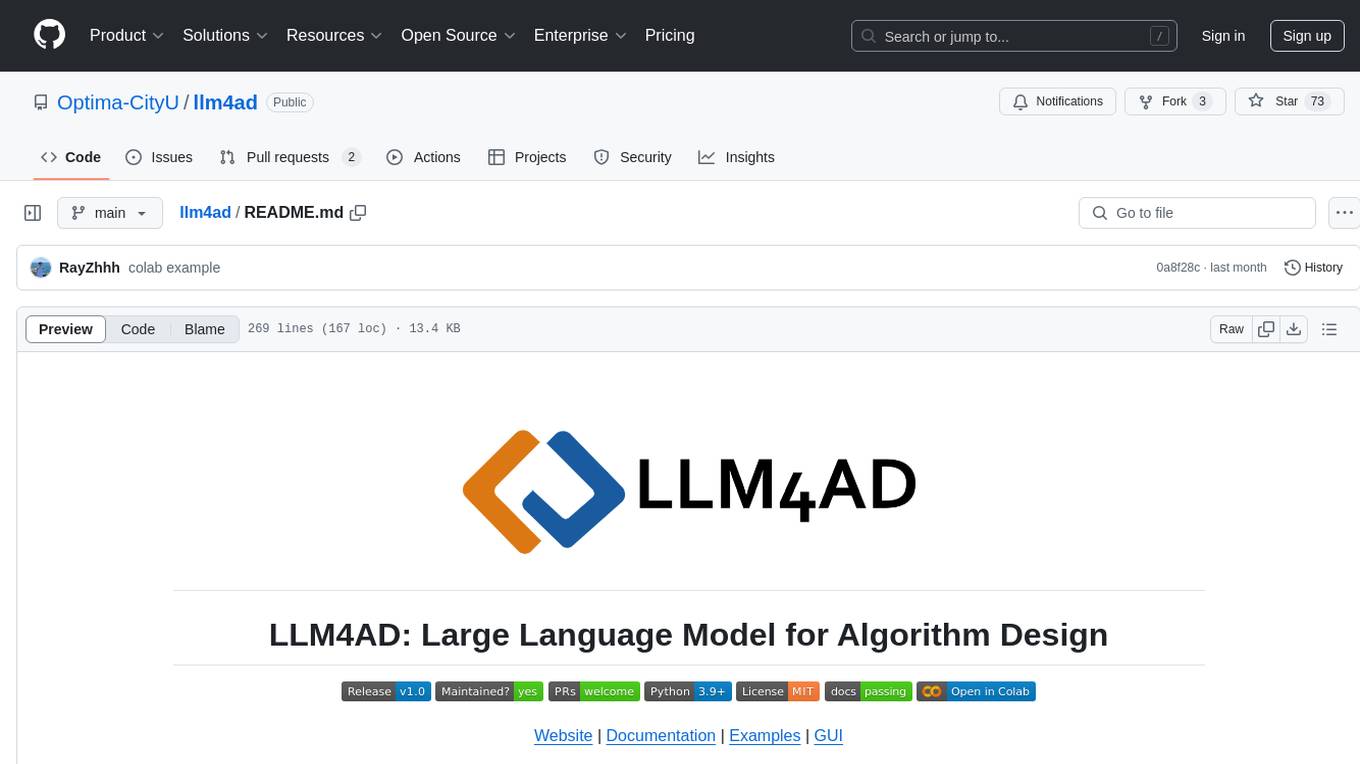
llm4ad
LLM4AD is an open-source Python-based platform leveraging Large Language Models (LLMs) for Automatic Algorithm Design (AD). It provides unified interfaces for methods, tasks, and LLMs, along with features like evaluation acceleration, secure evaluation, logs, GUI support, and more. The platform was originally developed for optimization tasks but is versatile enough to be used in other areas such as machine learning, science discovery, game theory, and engineering design. It offers various search methods and algorithm design tasks across different domains. LLM4AD supports remote LLM API, local HuggingFace LLM deployment, and custom LLM interfaces. The project is licensed under the MIT License and welcomes contributions, collaborations, and issue reports.
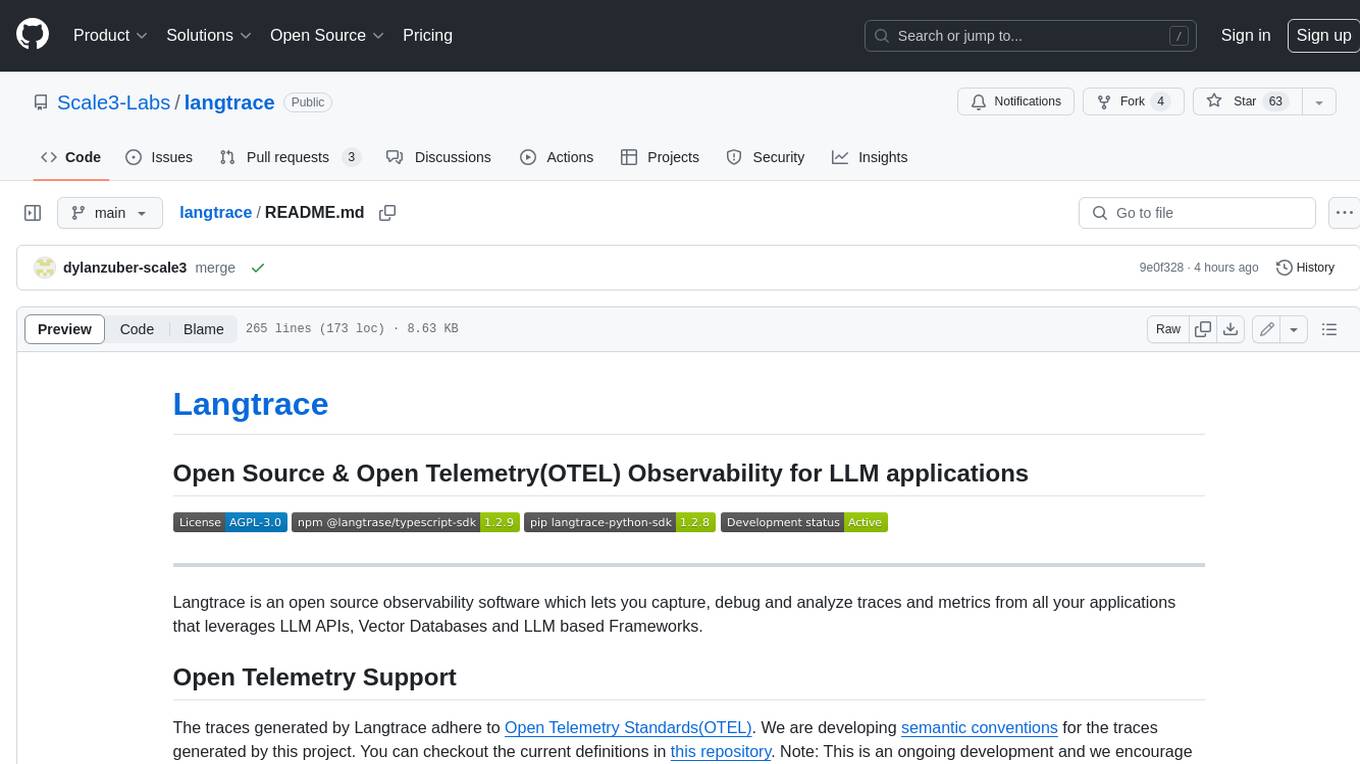
langtrace
Langtrace is an open source observability software that lets you capture, debug, and analyze traces and metrics from all your applications that leverage LLM APIs, Vector Databases, and LLM-based Frameworks. It supports Open Telemetry Standards (OTEL), and the traces generated adhere to these standards. Langtrace offers both a managed SaaS version (Langtrace Cloud) and a self-hosted option. The SDKs for both Typescript/Javascript and Python are available, making it easy to integrate Langtrace into your applications. Langtrace automatically captures traces from various vendors, including OpenAI, Anthropic, Azure OpenAI, Langchain, LlamaIndex, Pinecone, and ChromaDB.
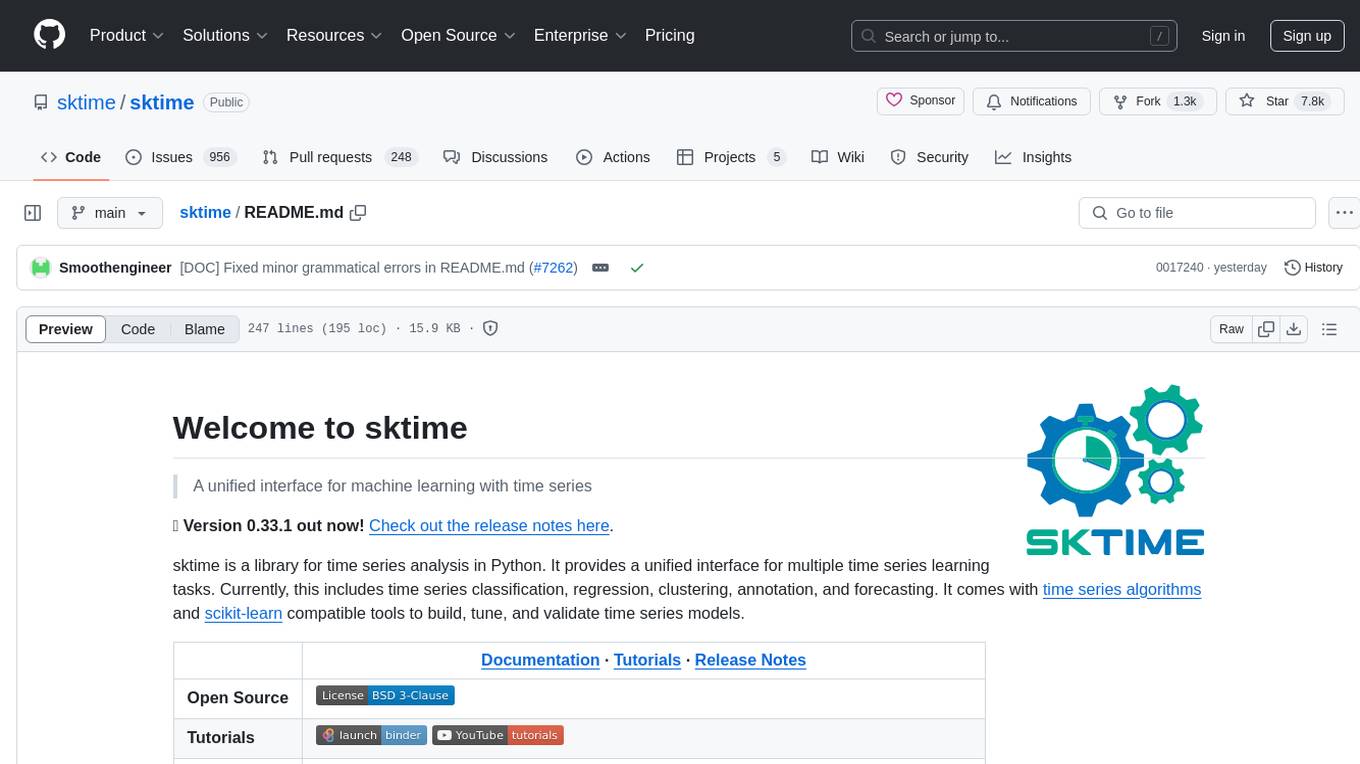
sktime
sktime is a Python library for time series analysis that provides a unified interface for various time series learning tasks such as classification, regression, clustering, annotation, and forecasting. It offers time series algorithms and tools compatible with scikit-learn for building, tuning, and validating time series models. sktime aims to enhance the interoperability and usability of the time series analysis ecosystem by empowering users to apply algorithms across different tasks and providing interfaces to related libraries like scikit-learn, statsmodels, tsfresh, PyOD, and fbprophet.
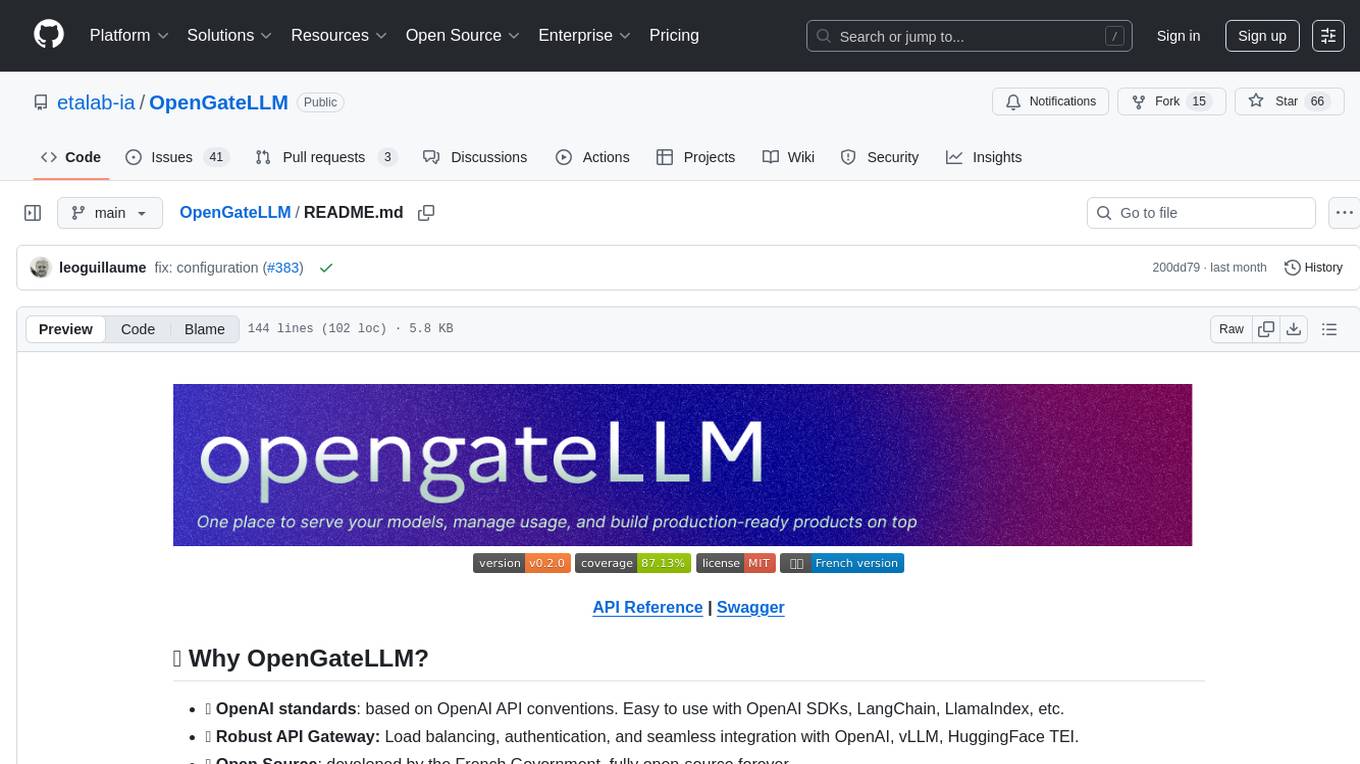
OpenGateLLM
OpenGateLLM is an open-source API gateway developed by the French Government, designed to serve AI models in production. It follows OpenAI standards and offers robust features like RAG integration, audio transcription, OCR, and more. With support for multiple AI backends and built-in security, OpenGateLLM provides a production-ready solution for various AI tasks.
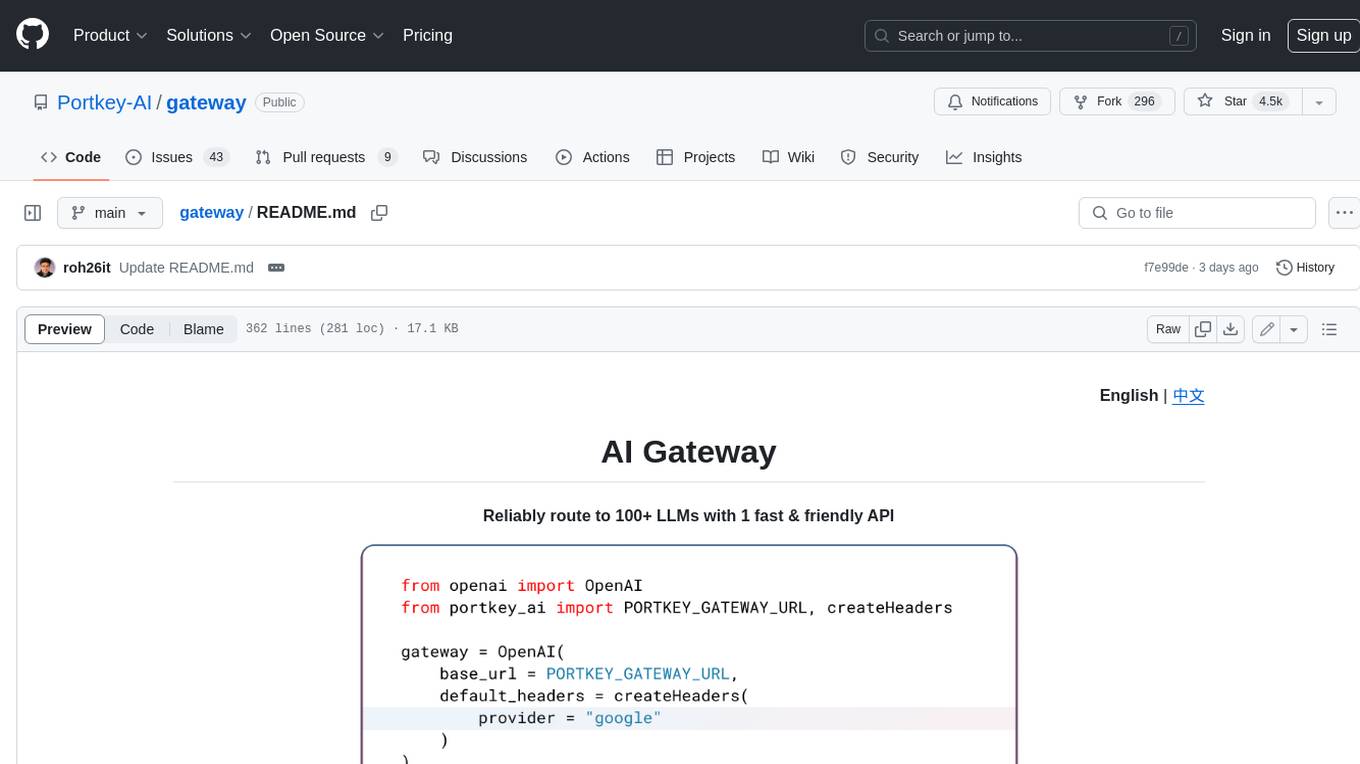
gateway
Gateway is a tool that streamlines requests to 100+ open & closed source models with a unified API. It is production-ready with support for caching, fallbacks, retries, timeouts, load balancing, and can be edge-deployed for minimum latency. It is blazing fast with a tiny footprint, supports load balancing across multiple models, providers, and keys, ensures app resilience with fallbacks, offers automatic retries with exponential fallbacks, allows configurable request timeouts, supports multimodal routing, and can be extended with plug-in middleware. It is battle-tested over 300B tokens and enterprise-ready for enhanced security, scale, and custom deployments.
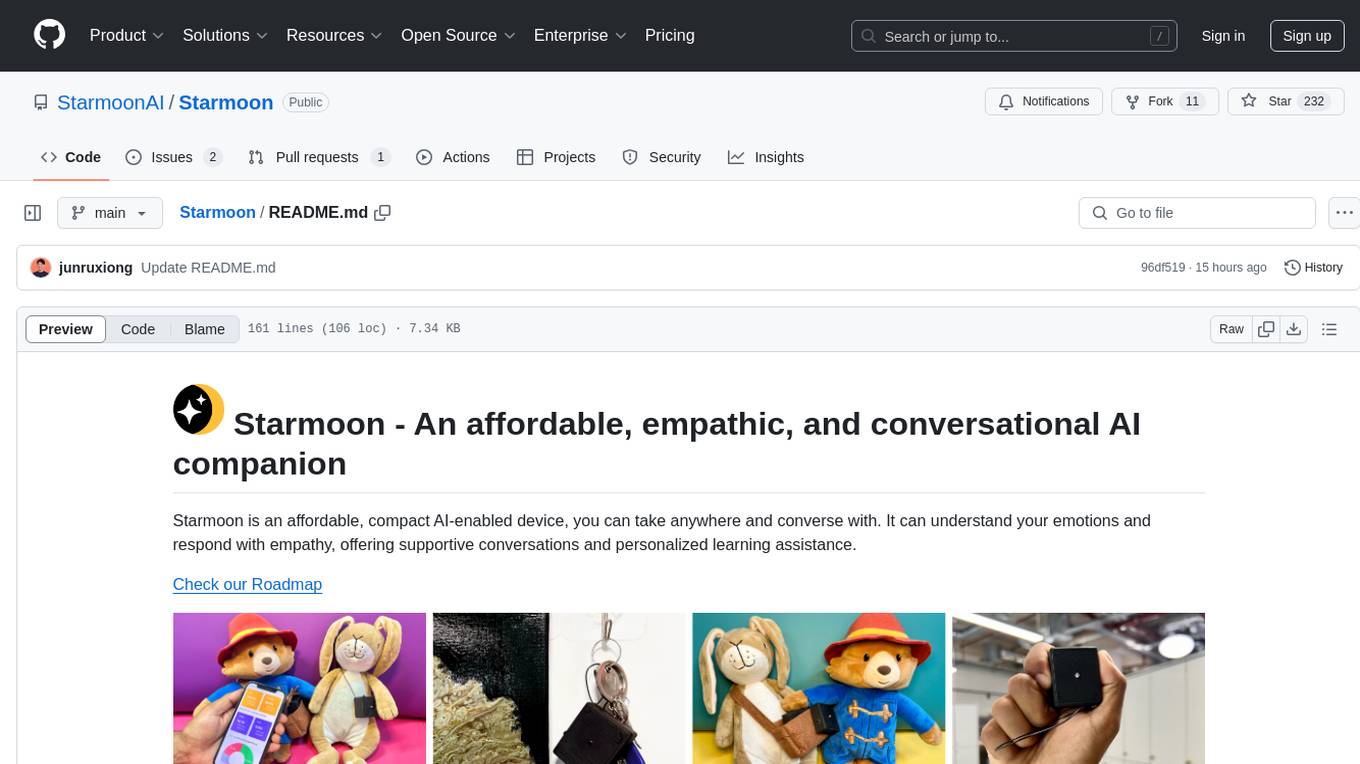
Starmoon
Starmoon is an affordable, compact AI-enabled device that can understand and respond to your emotions with empathy. It offers supportive conversations and personalized learning assistance. The device is cost-effective, voice-enabled, open-source, compact, and aims to reduce screen time. Users can assemble the device themselves using off-the-shelf components and deploy it locally for data privacy. Starmoon integrates various APIs for AI language models, speech-to-text, text-to-speech, and emotion intelligence. The hardware setup involves components like ESP32S3, microphone, amplifier, speaker, LED light, and button, along with software setup instructions for developers. The project also includes a web app, backend API, and background task dashboard for monitoring and management.
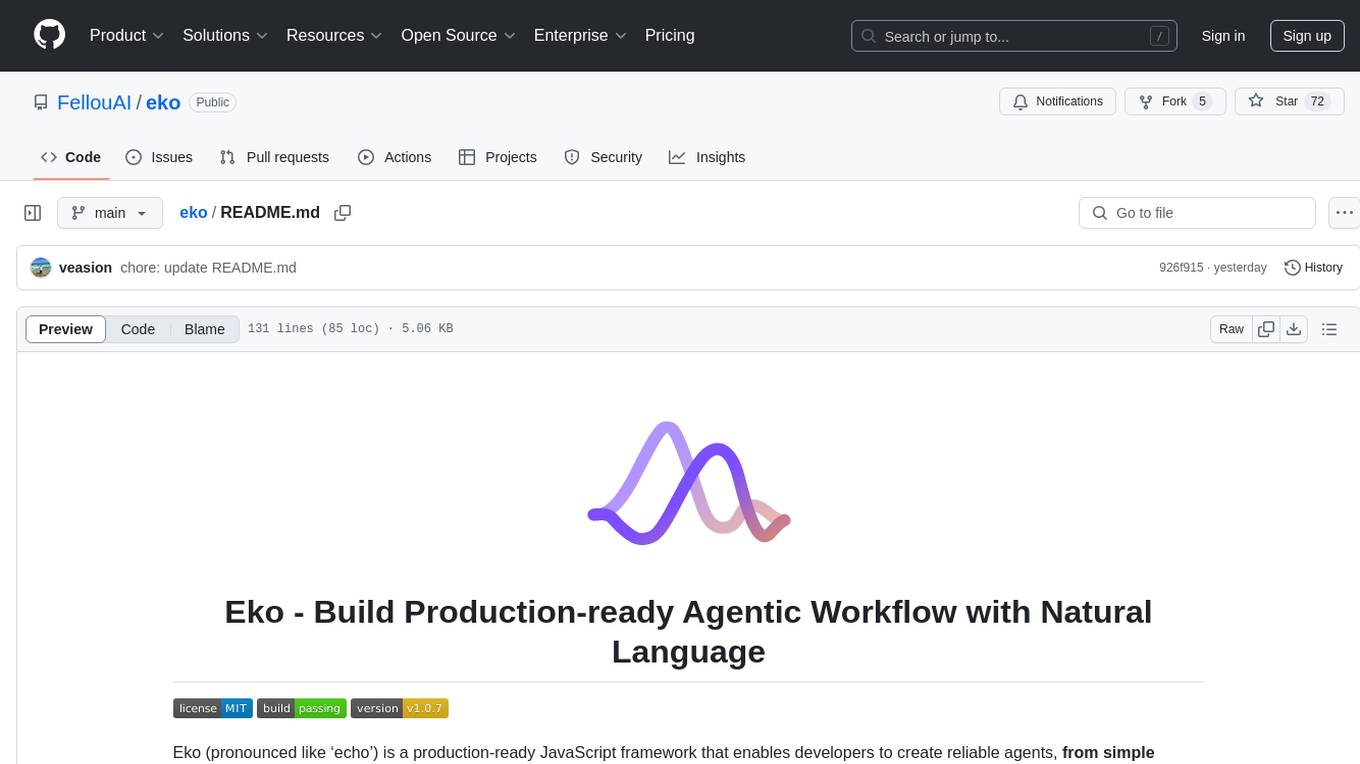
eko
Eko is a lightweight and flexible command-line tool for managing environment variables in your projects. It allows you to easily set, get, and delete environment variables for different environments, making it simple to manage configurations across development, staging, and production environments. With Eko, you can streamline your workflow and ensure consistency in your application settings without the need for complex setup or configuration files.
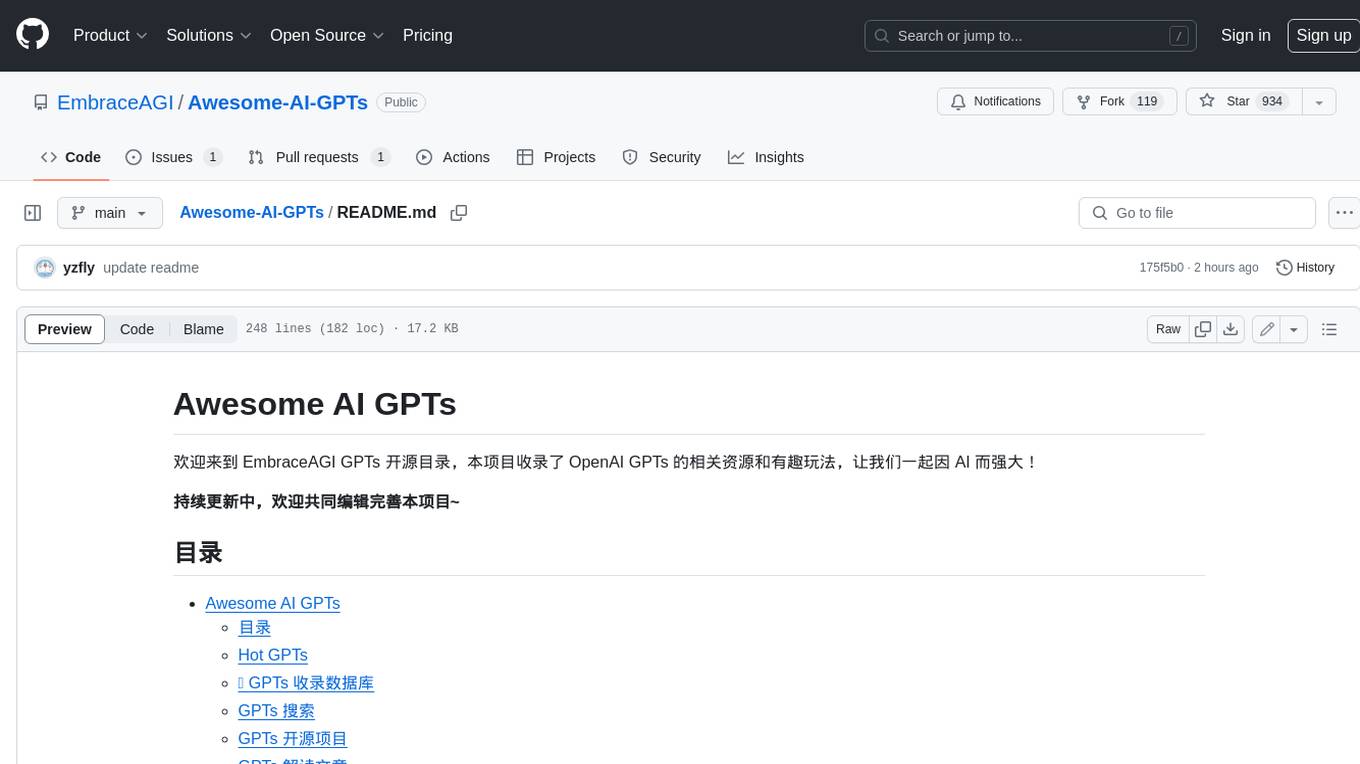
Awesome-AI-GPTs
Awesome AI GPTs is an open repository that collects resources and fun ways to use OpenAI GPTs. It includes databases, search tools, open-source projects, articles, attack and defense strategies, installation of custom plugins, knowledge bases, and community interactions related to GPTs. Users can find curated lists, leaked prompts, and various GPT applications in this repository. The project aims to empower users with AI capabilities and foster collaboration in the AI community.
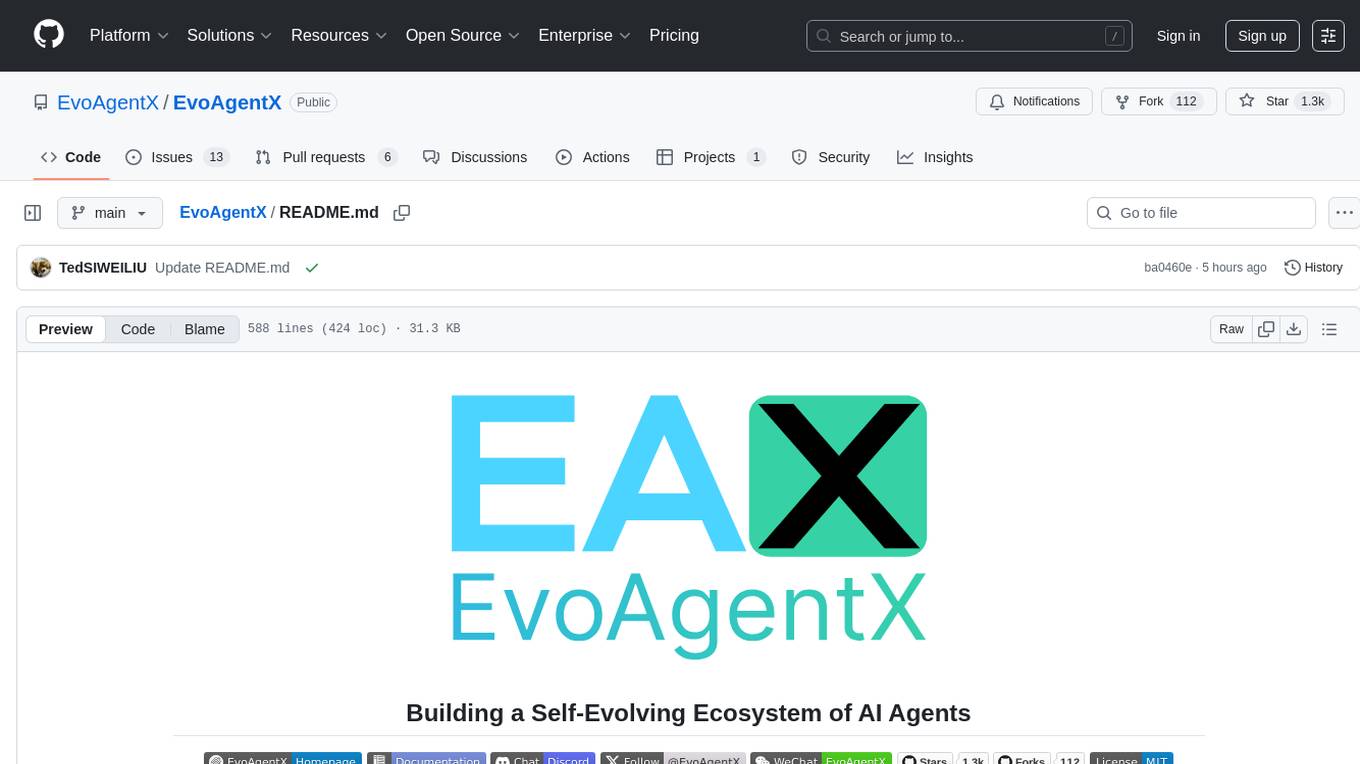
EvoAgentX
EvoAgentX is an open-source framework for building, evaluating, and evolving LLM-based agents or agentic workflows in an automated, modular, and goal-driven manner. It enables developers and researchers to move beyond static prompt chaining or manual workflow orchestration by introducing a self-evolving agent ecosystem. The framework includes features such as agent workflow autoconstruction, built-in evaluation, self-evolution engine, plug-and-play compatibility, comprehensive built-in tools, memory module support, and human-in-the-loop interactions.
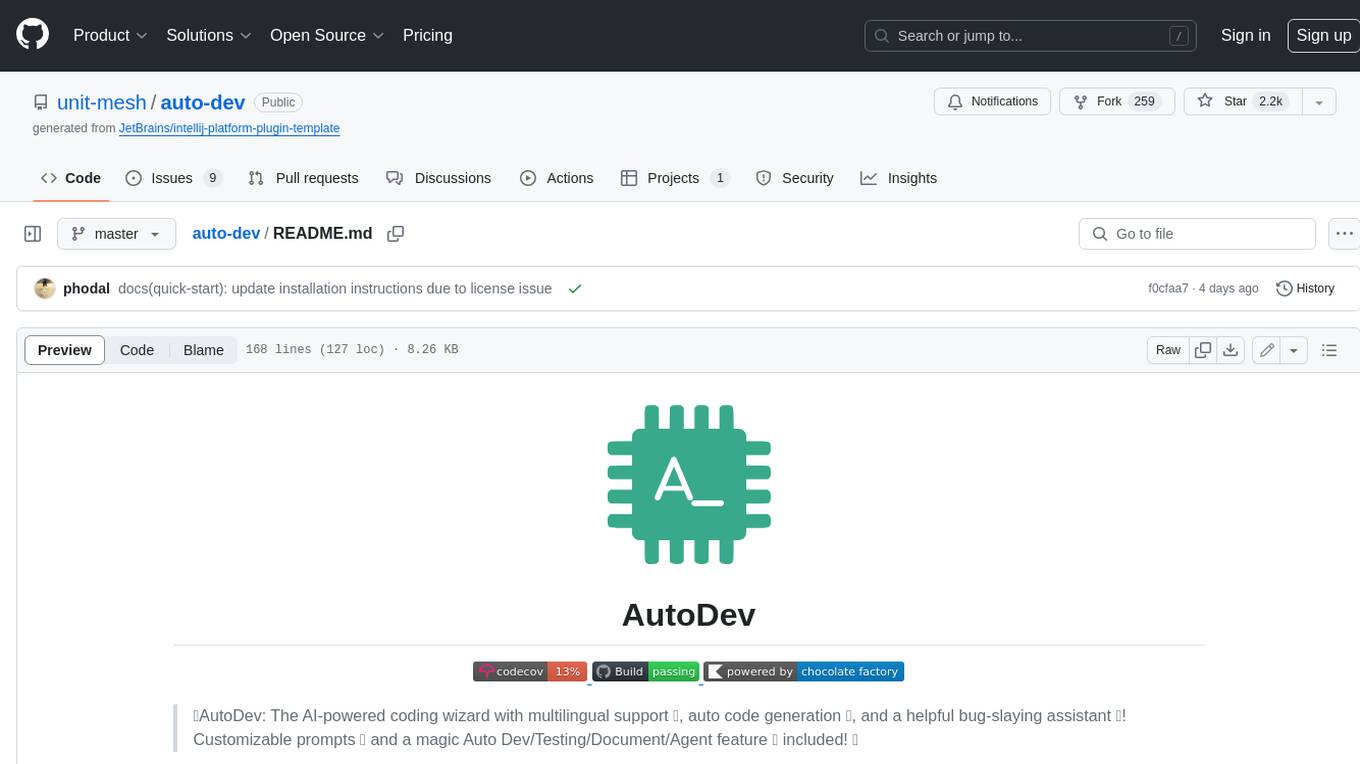
auto-dev
AutoDev is an AI-powered coding wizard that supports multiple languages, including Java, Kotlin, JavaScript/TypeScript, Rust, Python, Golang, C/C++/OC, and more. It offers a range of features, including auto development mode, copilot mode, chat with AI, customization options, SDLC support, custom AI agent integration, and language features such as language support, extensions, and a DevIns language for AI agent development. AutoDev is designed to assist developers with tasks such as auto code generation, bug detection, code explanation, exception tracing, commit message generation, code review content generation, smart refactoring, Dockerfile generation, CI/CD config file generation, and custom shell/command generation. It also provides a built-in LLM fine-tune model and supports UnitEval for LLM result evaluation and UnitGen for code-LLM fine-tune data generation.
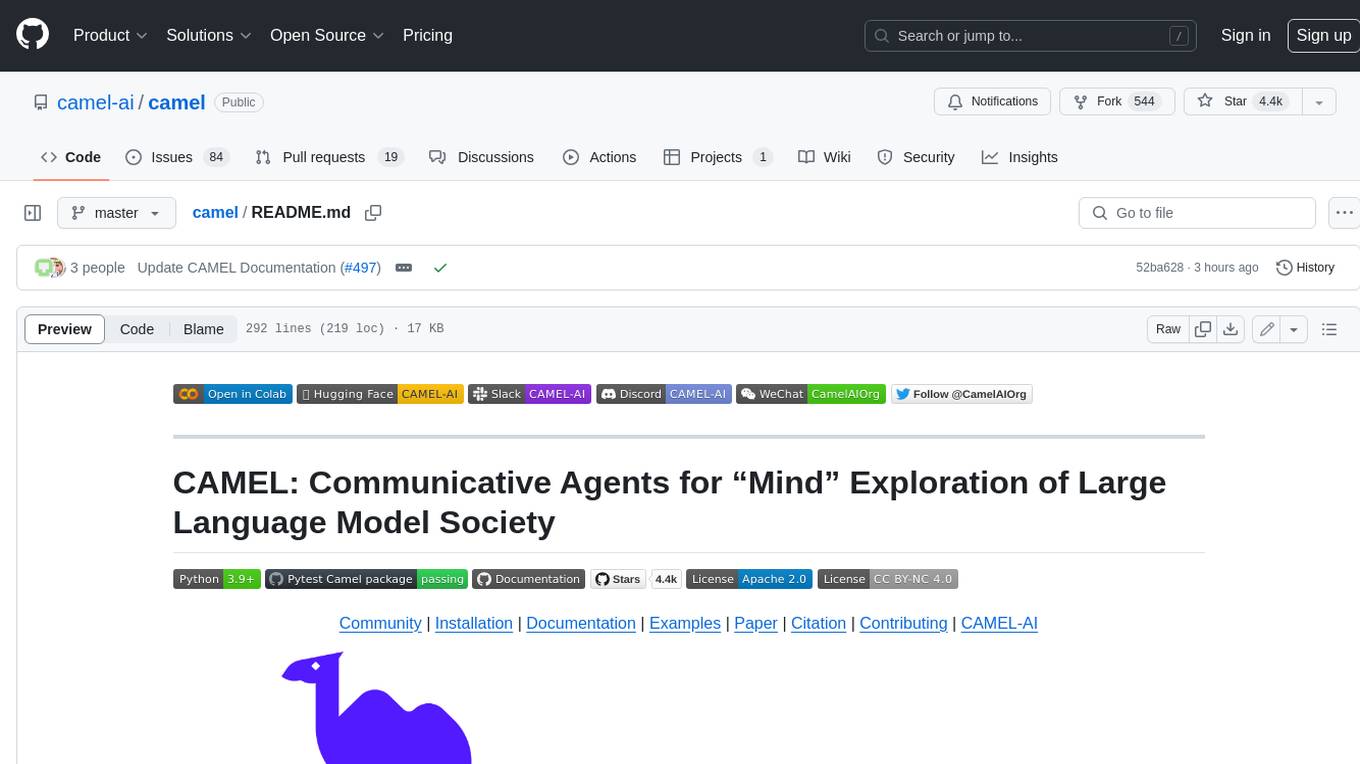
camel
CAMEL is an open-source library designed for the study of autonomous and communicative agents. We believe that studying these agents on a large scale offers valuable insights into their behaviors, capabilities, and potential risks. To facilitate research in this field, we implement and support various types of agents, tasks, prompts, models, and simulated environments.
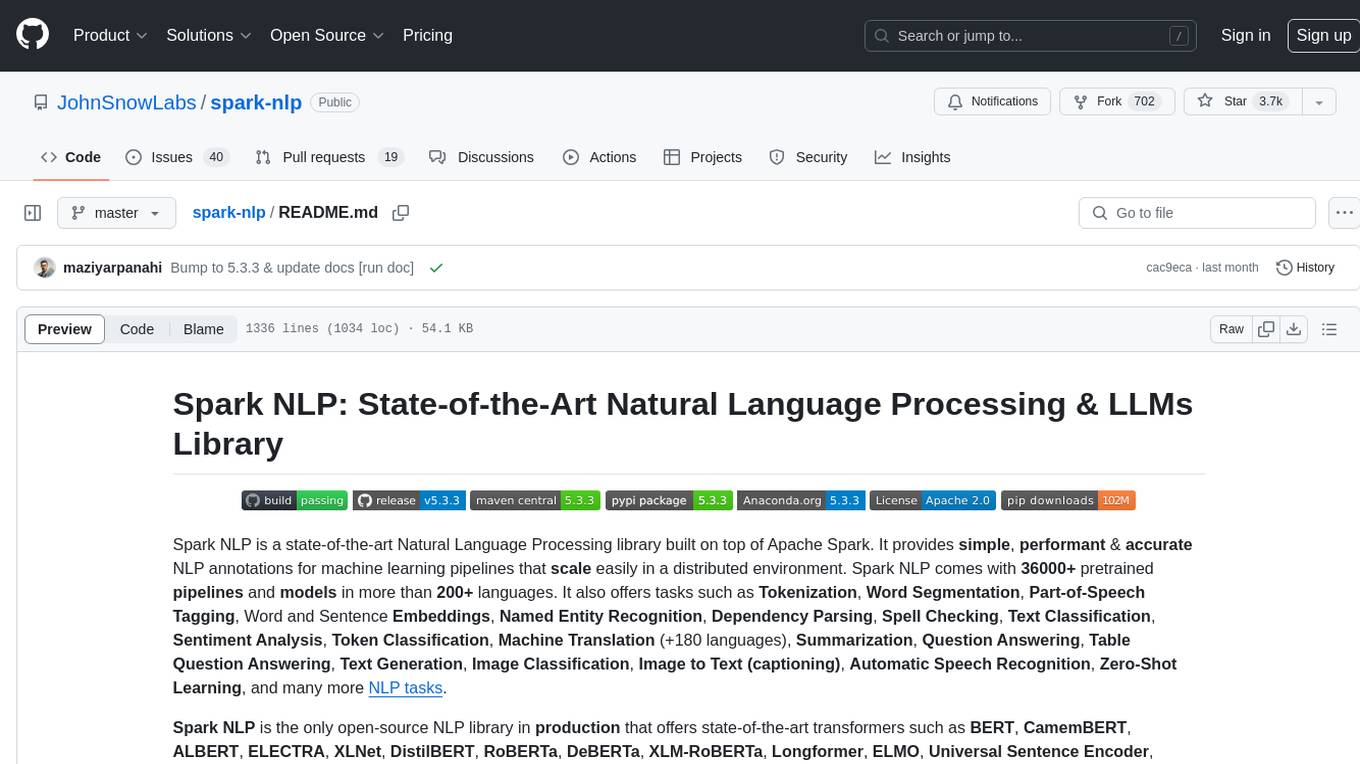
spark-nlp
Spark NLP is a state-of-the-art Natural Language Processing library built on top of Apache Spark. It provides simple, performant, and accurate NLP annotations for machine learning pipelines that scale easily in a distributed environment. Spark NLP comes with 36000+ pretrained pipelines and models in more than 200+ languages. It offers tasks such as Tokenization, Word Segmentation, Part-of-Speech Tagging, Named Entity Recognition, Dependency Parsing, Spell Checking, Text Classification, Sentiment Analysis, Token Classification, Machine Translation, Summarization, Question Answering, Table Question Answering, Text Generation, Image Classification, Image to Text (captioning), Automatic Speech Recognition, Zero-Shot Learning, and many more NLP tasks. Spark NLP is the only open-source NLP library in production that offers state-of-the-art transformers such as BERT, CamemBERT, ALBERT, ELECTRA, XLNet, DistilBERT, RoBERTa, DeBERTa, XLM-RoBERTa, Longformer, ELMO, Universal Sentence Encoder, Llama-2, M2M100, BART, Instructor, E5, Google T5, MarianMT, OpenAI GPT2, Vision Transformers (ViT), OpenAI Whisper, and many more not only to Python and R, but also to JVM ecosystem (Java, Scala, and Kotlin) at scale by extending Apache Spark natively.
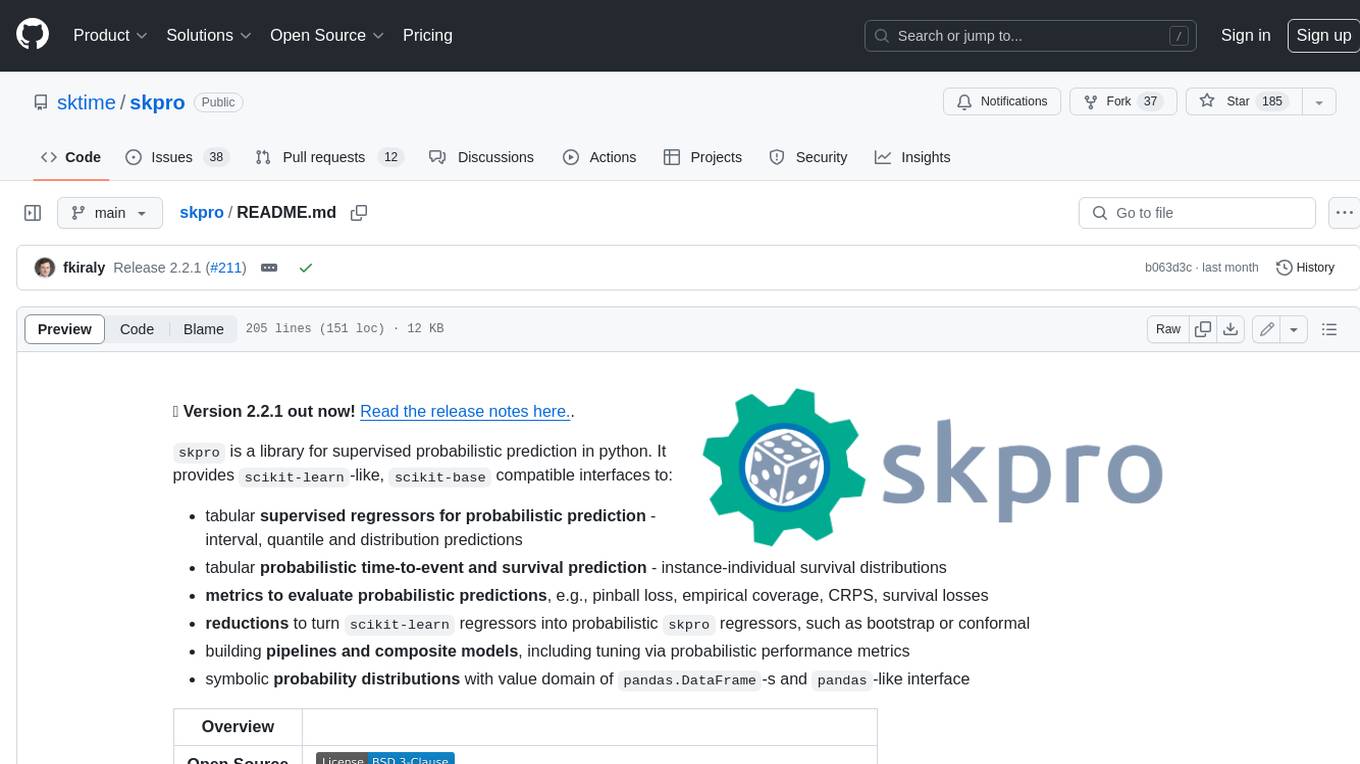
skpro
skpro is a library for supervised probabilistic prediction in python. It provides `scikit-learn`-like, `scikit-base` compatible interfaces to: * tabular **supervised regressors for probabilistic prediction** \- interval, quantile and distribution predictions * tabular **probabilistic time-to-event and survival prediction** \- instance-individual survival distributions * **metrics to evaluate probabilistic predictions** , e.g., pinball loss, empirical coverage, CRPS, survival losses * **reductions** to turn `scikit-learn` regressors into probabilistic `skpro` regressors, such as bootstrap or conformal * building **pipelines and composite models** , including tuning via probabilistic performance metrics * symbolic **probability distributions** with value domain of `pandas.DataFrame`-s and `pandas`-like interface
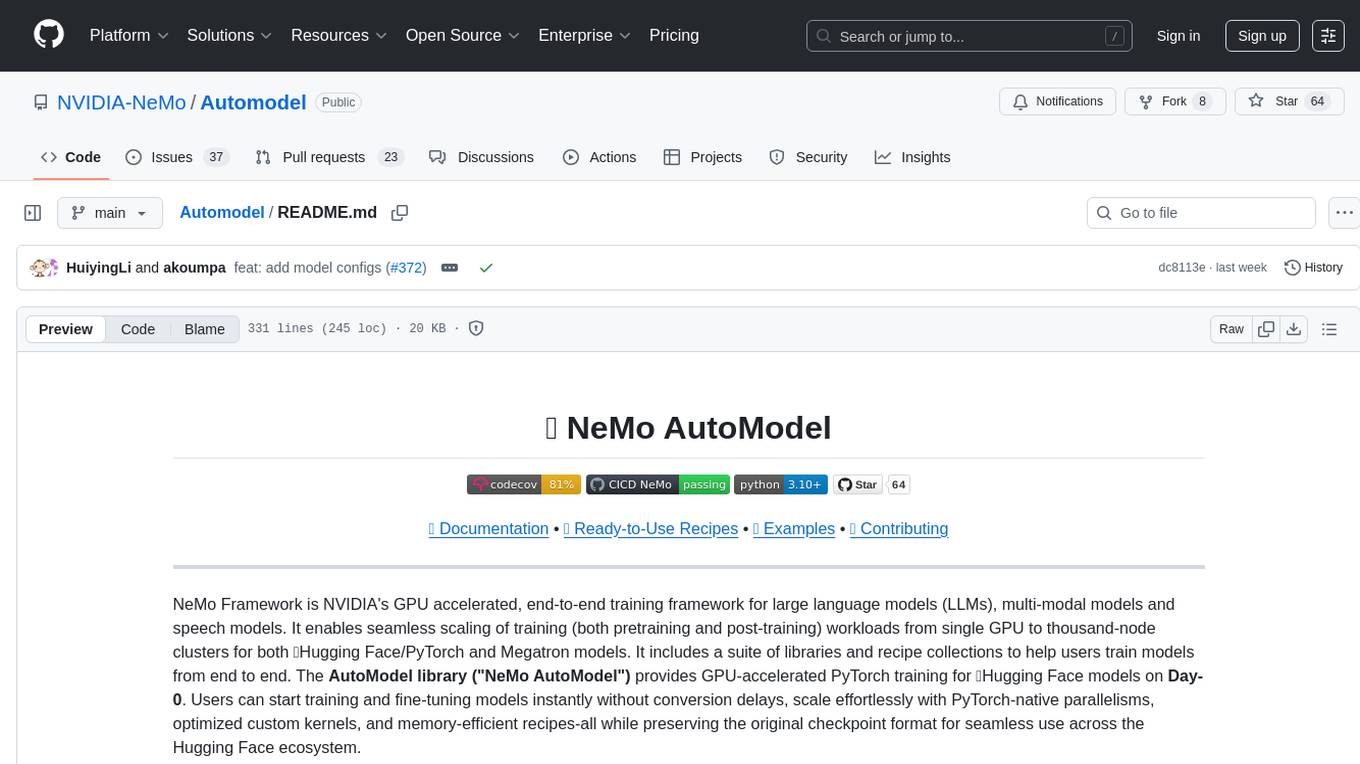
Automodel
Automodel is a Python library for automating the process of building and evaluating machine learning models. It provides a set of tools and utilities to streamline the model development workflow, from data preprocessing to model selection and evaluation. With Automodel, users can easily experiment with different algorithms, hyperparameters, and feature engineering techniques to find the best model for their dataset. The library is designed to be user-friendly and customizable, allowing users to define their own pipelines and workflows. Automodel is suitable for data scientists, machine learning engineers, and anyone looking to quickly build and test machine learning models without the need for manual intervention.
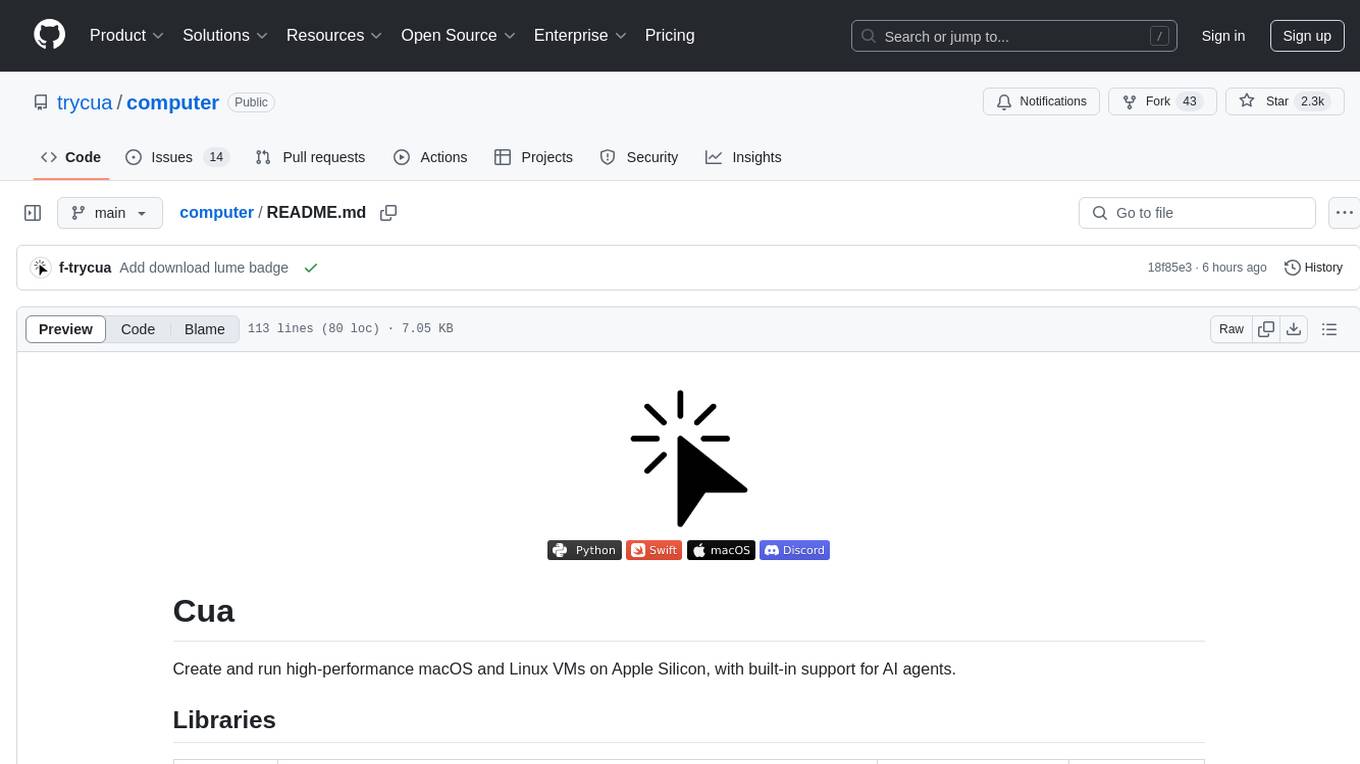
computer
Cua is a tool for creating and running high-performance macOS and Linux VMs on Apple Silicon, with built-in support for AI agents. It provides libraries like Lume for running VMs with near-native performance, Computer for interacting with sandboxes, and Agent for running agentic workflows. Users can refer to the documentation for onboarding and explore demos showcasing the tool's capabilities. Additionally, accessory libraries like Core, PyLume, Computer Server, and SOM offer additional functionality. Contributions to Cua are welcome, and the tool is open-sourced under the MIT License.
For similar tasks

MaixPy
MaixPy is a Python SDK that enables users to easily create AI vision projects on edge devices. It provides a user-friendly API for accessing NPU, making it suitable for AI Algorithm Engineers, STEM teachers, Makers, Engineers, Students, Enterprises, and Contestants. The tool supports Python programming, MaixVision Workstation, AI vision, video streaming, voice recognition, and peripheral usage. It also offers an online AI training platform called MaixHub. MaixPy is designed for new hardware platforms like MaixCAM, offering improved performance and features compared to older versions. The ecosystem includes hardware, software, tools, documentation, and a cloud platform.
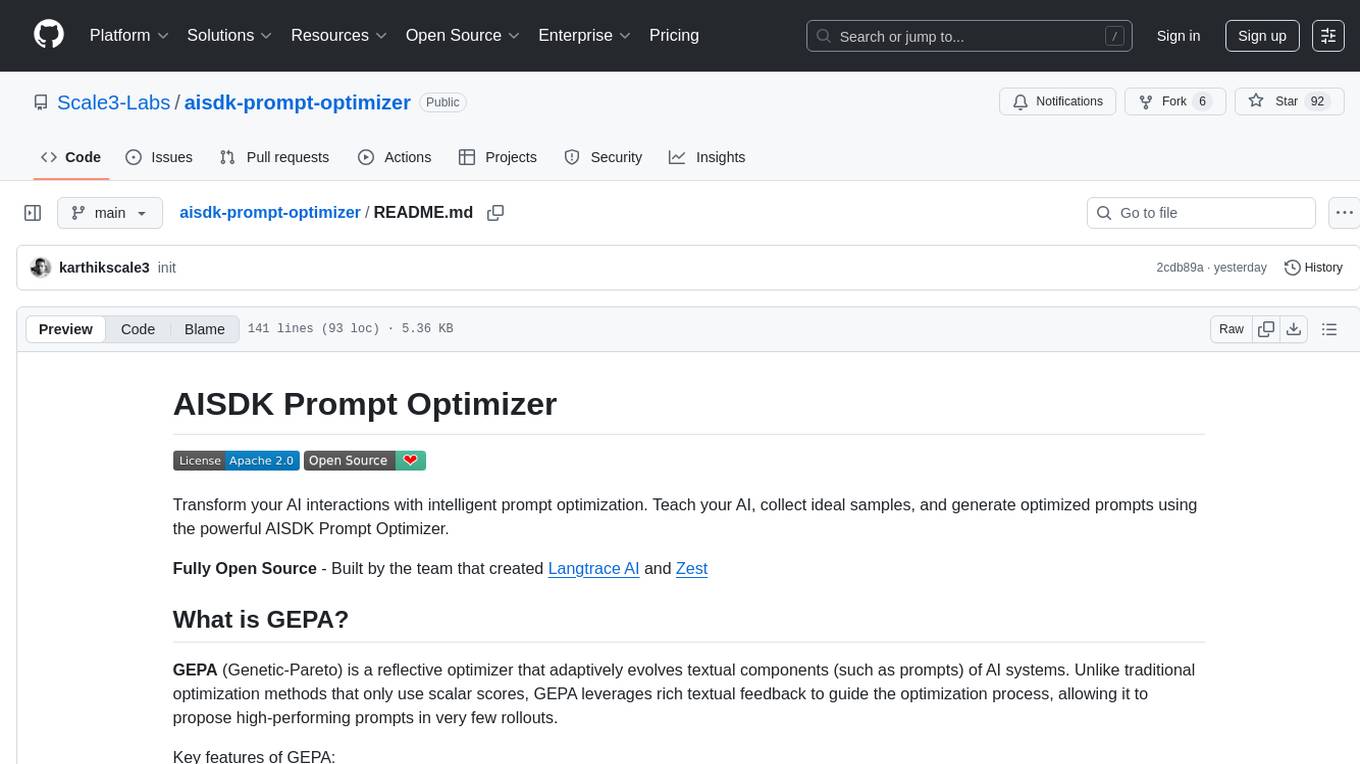
aisdk-prompt-optimizer
AISDK Prompt Optimizer is an open-source tool designed to transform AI interactions by optimizing prompts. It utilizes the GEPA reflective optimizer to evolve textual components of AI systems, providing features such as reflective prompt mutation, rich textual feedback, and Pareto-based selection. Users can teach their AI desired behaviors, collect ideal samples, run optimization to generate optimized prompts, and deploy the results in their applications. The tool leverages advanced optimization algorithms to guide AI through interactive conversations and refine prompt candidates for improved performance.
For similar jobs

MaixPy
MaixPy is a Python SDK that enables users to easily create AI vision projects on edge devices. It provides a user-friendly API for accessing NPU, making it suitable for AI Algorithm Engineers, STEM teachers, Makers, Engineers, Students, Enterprises, and Contestants. The tool supports Python programming, MaixVision Workstation, AI vision, video streaming, voice recognition, and peripheral usage. It also offers an online AI training platform called MaixHub. MaixPy is designed for new hardware platforms like MaixCAM, offering improved performance and features compared to older versions. The ecosystem includes hardware, software, tools, documentation, and a cloud platform.
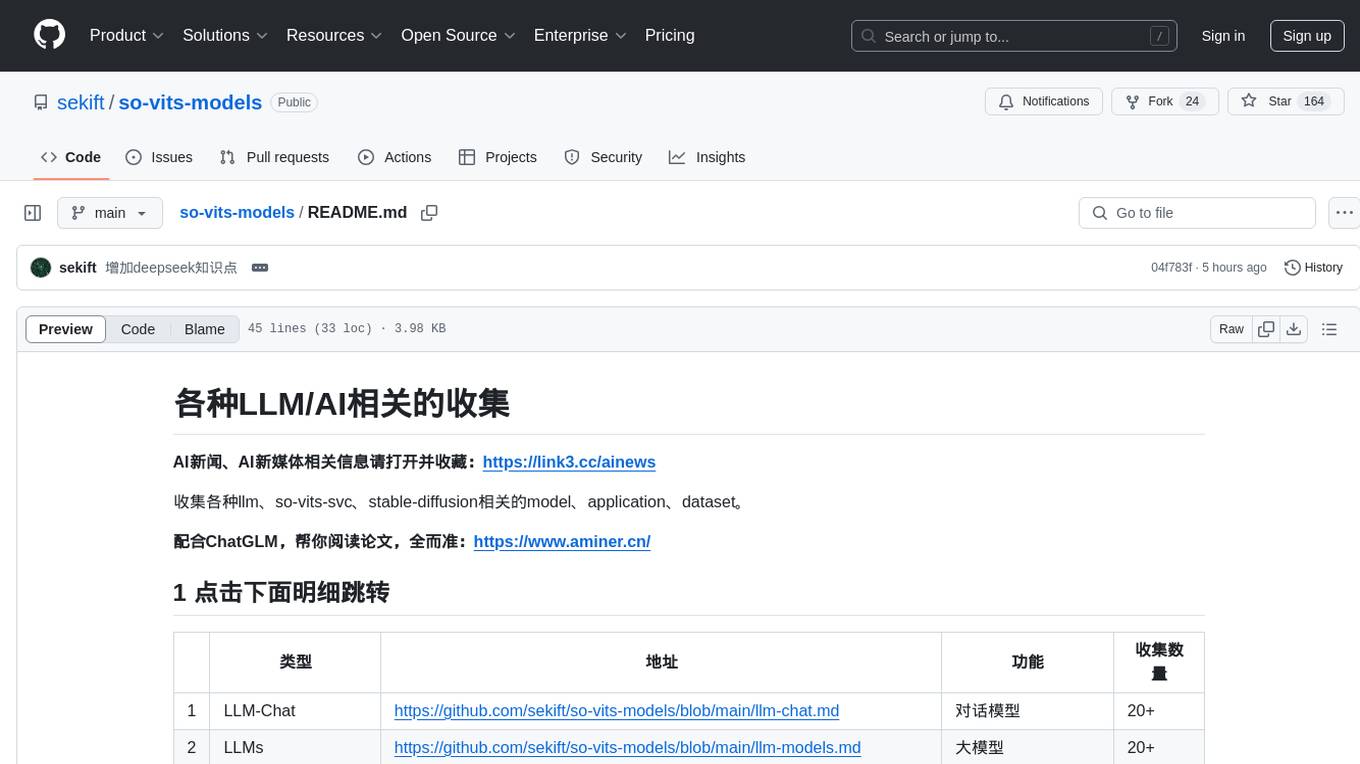
so-vits-models
This repository collects various LLM, AI-related models, applications, and datasets, including LLM-Chat for dialogue models, LLMs for large models, so-vits-svc for sound-related models, stable-diffusion for image-related models, and virtual-digital-person for generating videos. It also provides resources for deep learning courses and overviews, AI competitions, and specific AI tasks such as text, image, voice, and video processing.
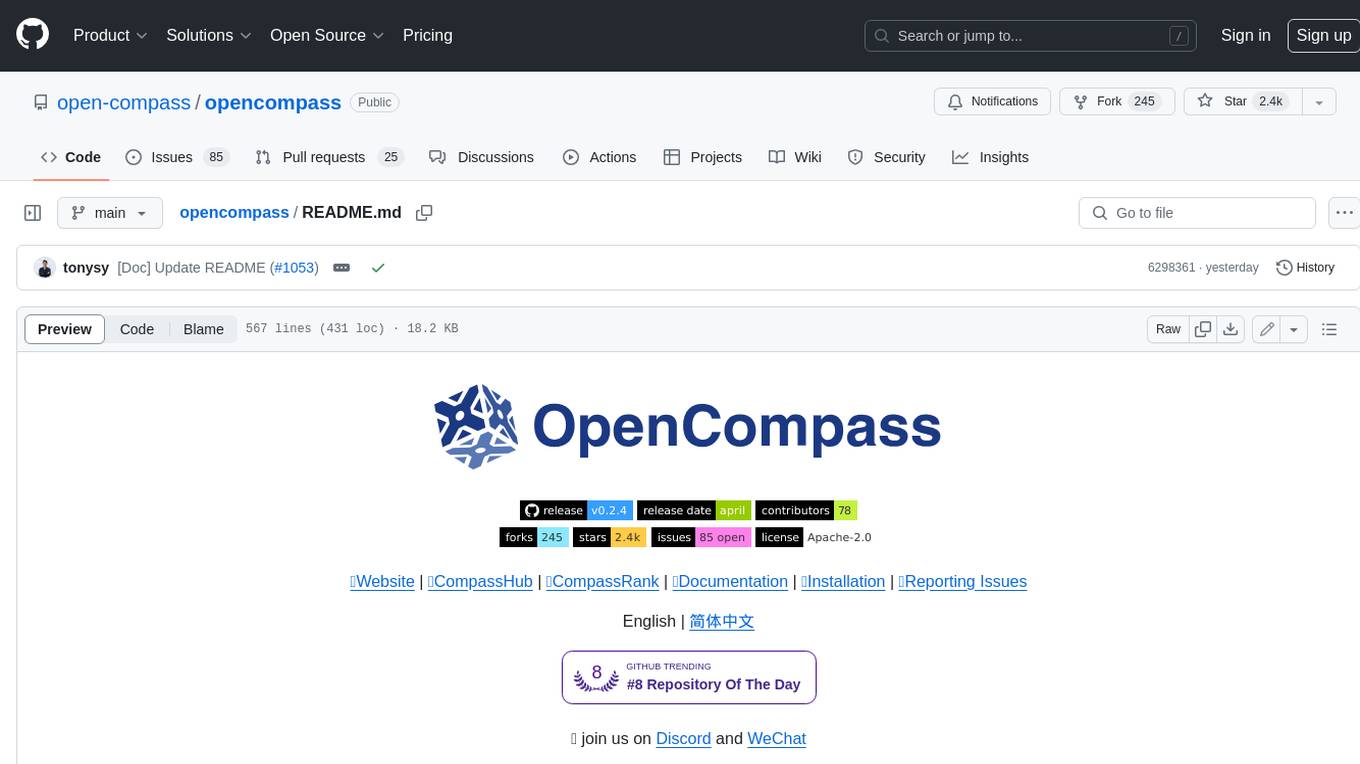
opencompass
OpenCompass is a one-stop platform for large model evaluation, aiming to provide a fair, open, and reproducible benchmark for large model evaluation. Its main features include: * Comprehensive support for models and datasets: Pre-support for 20+ HuggingFace and API models, a model evaluation scheme of 70+ datasets with about 400,000 questions, comprehensively evaluating the capabilities of the models in five dimensions. * Efficient distributed evaluation: One line command to implement task division and distributed evaluation, completing the full evaluation of billion-scale models in just a few hours. * Diversified evaluation paradigms: Support for zero-shot, few-shot, and chain-of-thought evaluations, combined with standard or dialogue-type prompt templates, to easily stimulate the maximum performance of various models. * Modular design with high extensibility: Want to add new models or datasets, customize an advanced task division strategy, or even support a new cluster management system? Everything about OpenCompass can be easily expanded! * Experiment management and reporting mechanism: Use config files to fully record each experiment, and support real-time reporting of results.
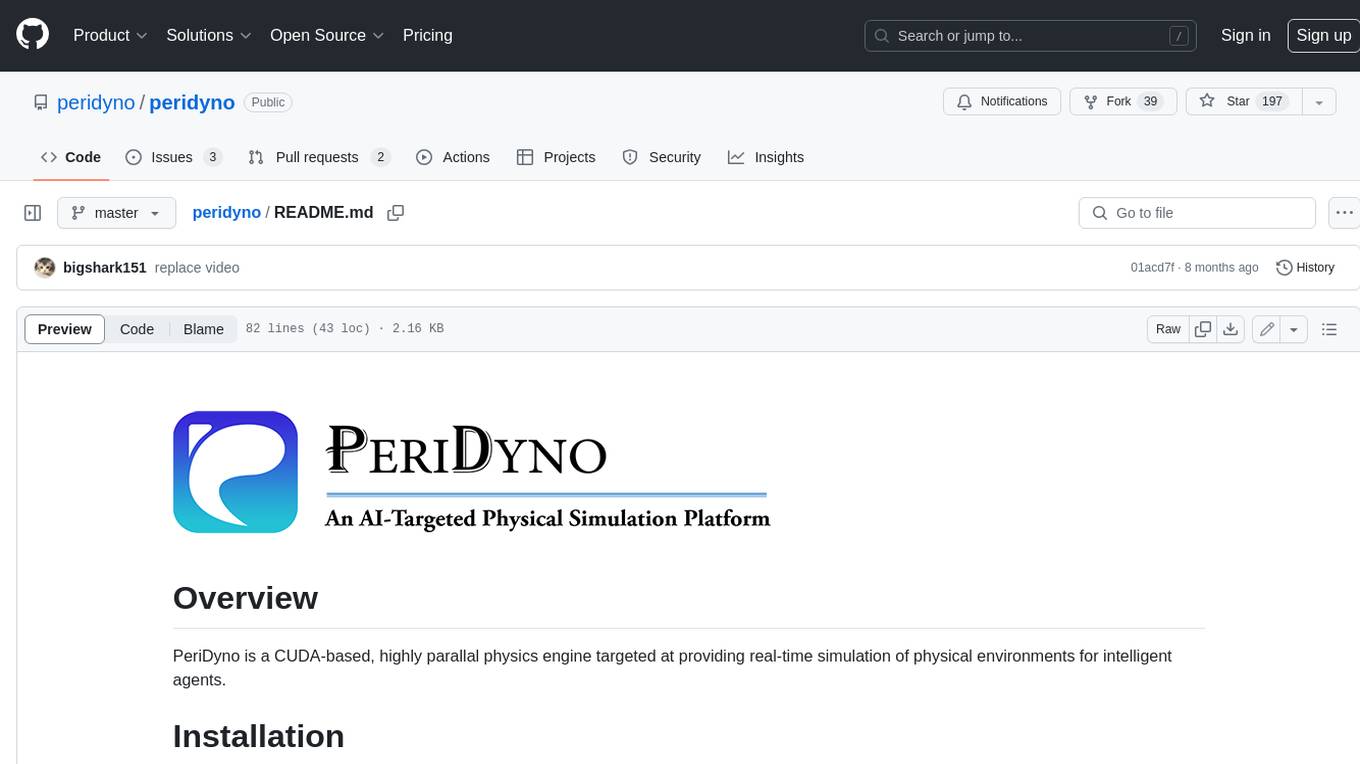
peridyno
PeriDyno is a CUDA-based, highly parallel physics engine targeted at providing real-time simulation of physical environments for intelligent agents. It is designed to be easy to use and integrate into existing projects, and it provides a wide range of features for simulating a variety of physical phenomena. PeriDyno is open source and available under the Apache 2.0 license.
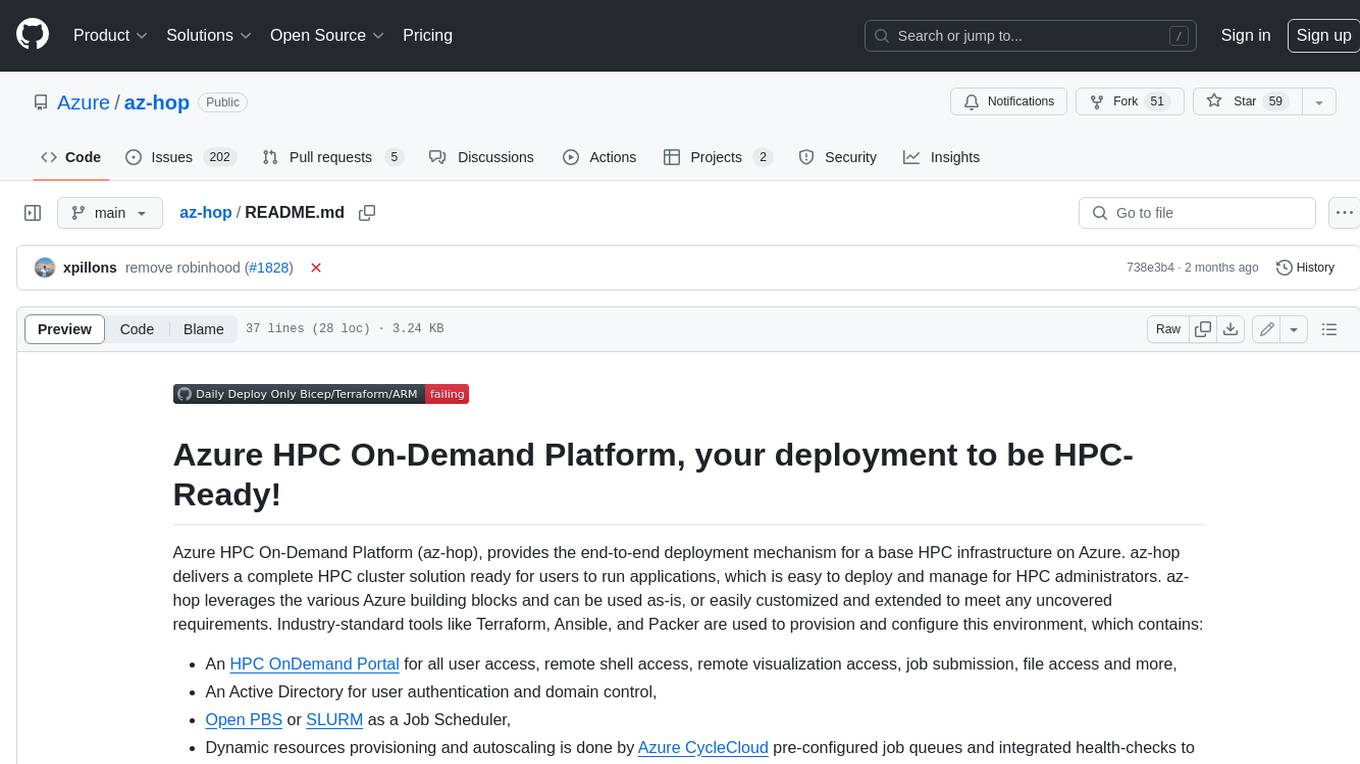
az-hop
Azure HPC On-Demand Platform (az-hop) provides an end-to-end deployment mechanism for a base HPC infrastructure on Azure. It delivers a complete HPC cluster solution ready for users to run applications, which is easy to deploy and manage for HPC administrators. az-hop leverages various Azure building blocks and can be used as-is or easily customized and extended to meet any uncovered requirements. Industry-standard tools like Terraform, Ansible, and Packer are used to provision and configure this environment, which contains: - An HPC OnDemand Portal for all user access, remote shell access, remote visualization access, job submission, file access, and more - An Active Directory for user authentication and domain control - Open PBS or SLURM as a Job Scheduler - Dynamic resources provisioning and autoscaling is done by Azure CycleCloud pre-configured job queues and integrated health-checks to quickly avoid non-optimal nodes - A Jumpbox to provide admin access - A common shared file system for home directory and applications is delivered by Azure Netapp Files - Grafana dashboards to monitor your cluster - Remote Visualization with noVNC and GPU acceleration with VirtualGL
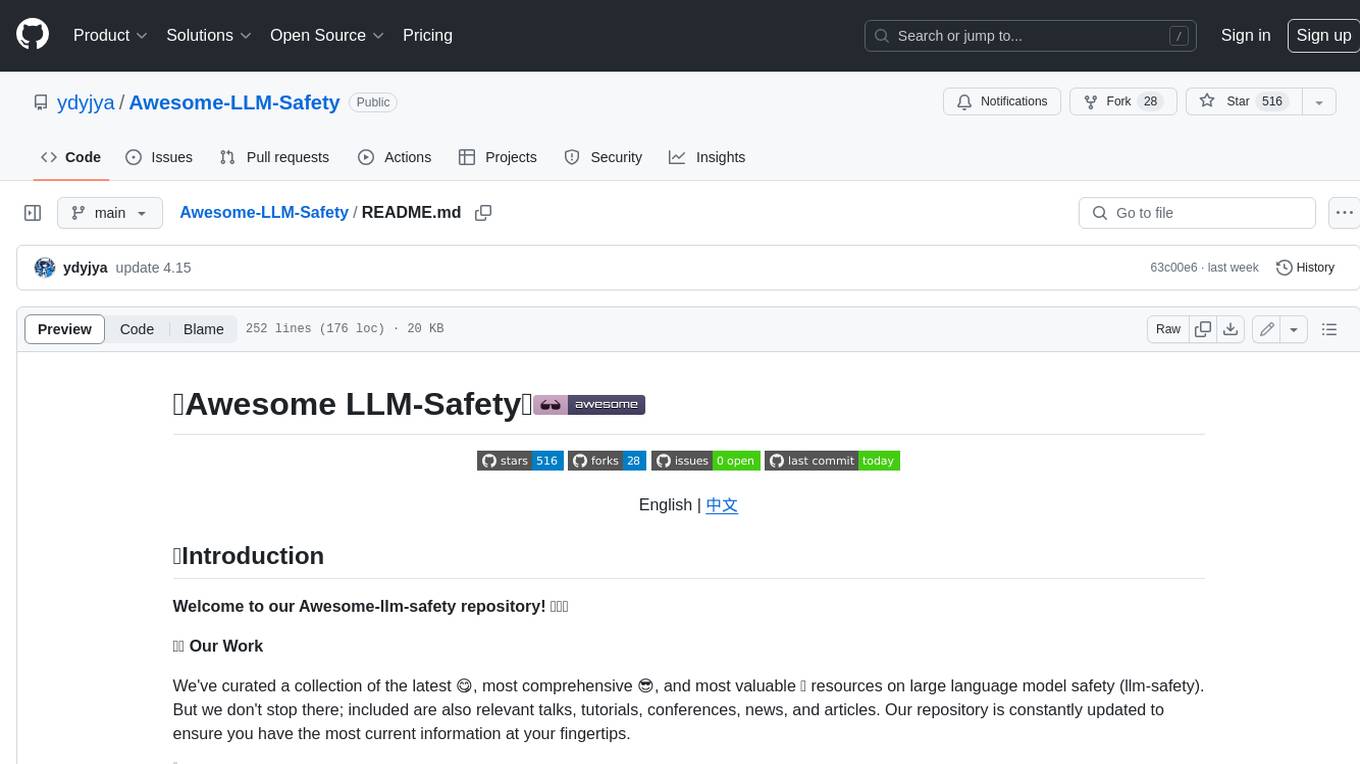
Awesome-LLM-Safety
Welcome to our Awesome-llm-safety repository! We've curated a collection of the latest, most comprehensive, and most valuable resources on large language model safety (llm-safety). But we don't stop there; included are also relevant talks, tutorials, conferences, news, and articles. Our repository is constantly updated to ensure you have the most current information at your fingertips.
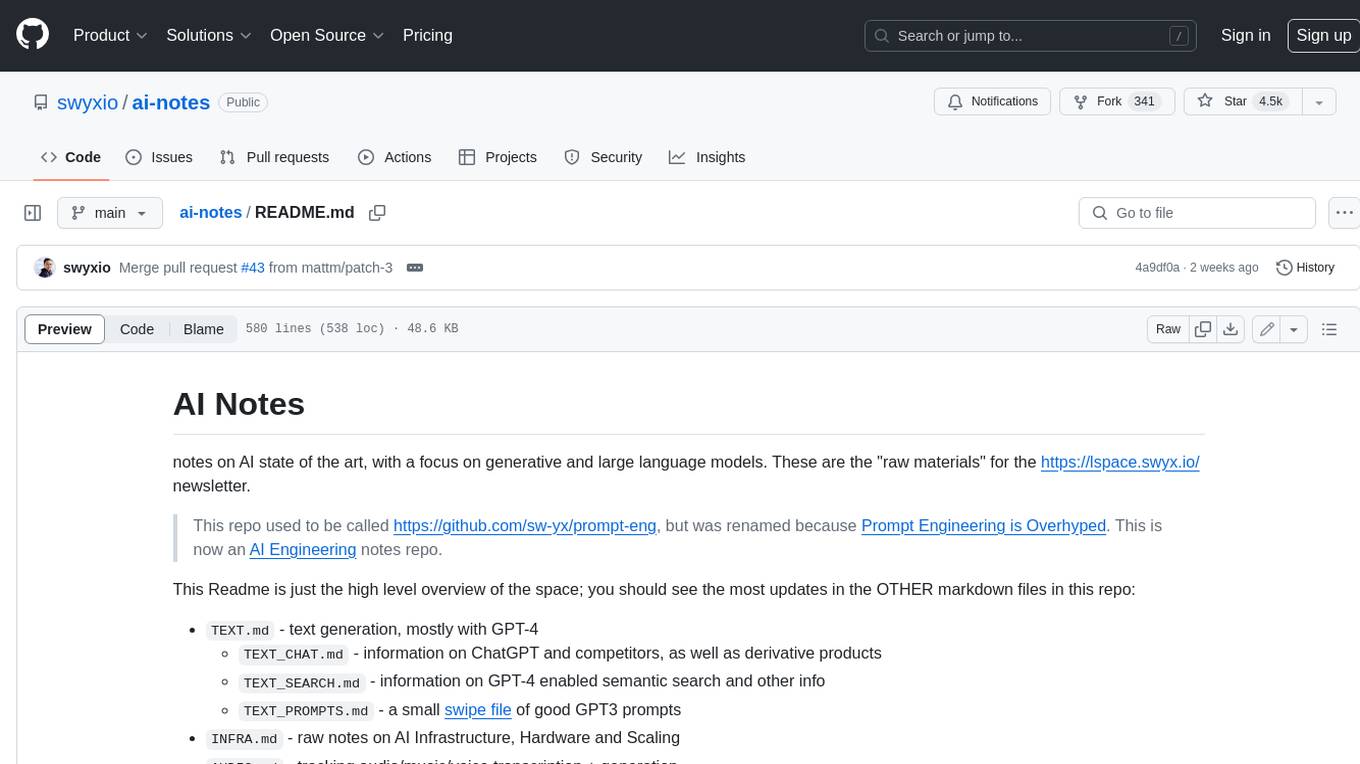
ai-notes
Notes on AI state of the art, with a focus on generative and large language models. These are the "raw materials" for the https://lspace.swyx.io/ newsletter. This repo used to be called https://github.com/sw-yx/prompt-eng, but was renamed because Prompt Engineering is Overhyped. This is now an AI Engineering notes repo.

free-for-life
A massive list including a huge amount of products and services that are completely free! ⭐ Star on GitHub • 🤝 Contribute # Table of Contents * APIs, Data & ML * Artificial Intelligence * BaaS * Code Editors * Code Generation * DNS * Databases * Design & UI * Domains * Email * Font * For Students * Forms * Linux Distributions * Messaging & Streaming * PaaS * Payments & Billing * SSL








